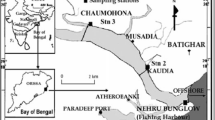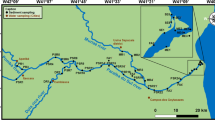Abstract
Water and suspended sediment samples from the Huanghe and its delta region were analyzed to determine arsenic concentrations. Comparison with the data of previous studies and other world pristine and less disturbed rivers reveals high levels of both dissolved and particulate As in this high turbidity river. Relatively stable distribution along the river course and in delta sediment cores shows that antrhopogenic activities have not altered As concentrations by any significant magnitude since the 1940s. Therefore, high levels of As in the Huanghe should be controlled by natural weathering and lithology. In the estuary, biological removal/regeneration and abiotic events (e.g. remobilization) have been identified to cause the active (non-conservative) As distributions. With the limited data set of the present study, the abiotic and biological contributions cannot be assessed accurately, however.
Similar content being viewed by others

References
Andreae M. O. (1977) Determination of arsenic species in natural waters.Anal. Chem. 49, 820–823.
Andreae M. O., Byrd J. T. and Froelich P. N. Jr. (1983) Aresenic, antimony, germanium, and tin in the Tejo estuary, Portugal: modelling a polluted estuary.Environ. Sci. Technol. 17, 731–737.
Andreae M. O. and Froelich P. N. (1984) Aresenic, antimony, and germanium biogeochemistry in the Baltic Sea.Tellus 36B, 101–117.
Andreae M. O. and Andreae T. W. (1989) Dissolved arsenic species in the Schelde estuary and watershed, Belgium.Estuarine, Coastal and Shelf Sci. 29, 421–433.
Ball P. W. (1989) Trend monitoring of dissolved metals in coastal sea water — a waste of effort?Mar. Poll. Bull. 20, 546–548.
Berner E. K. and Berner R. A. (1987)The Global Water Cycle: Geochemistry and Environment. Prentice-Hall, Englewood Cliffs, NJ.
Brannon J. M. and Patrick W. H. Jr. (1987) Fixation, transformation, and mobilization of arsenic in sediments.Environ. Sci. Technol. 21, 450–459.
Byrd J. T. (1988) The seasonal cycle of arsenic in estuarine and nearshore waters of the South Atlantic Bight.Mar. Chem. 25, 383–394.
Cauwet G. (1990) Distribution and behavior of organic and inorganic carbon in the Changjiang estuary. In:Biogeochemical Study of the Changjiang Estuary (eds. G. H. Yu, J. M. Martin and J. Y. Zhou), China Ocean Press, Beijing, pp. 570–588.
Commission of the Huanghe Resources Protection and Management (CHRPM) and Geography Department of Beijing University (GDBU) (1980) Some problems related to the environmental geochemistry of arsenic over the Huanghe drainage basin.Proc. Symp. on the Regional Environ. Sci., Sci. Press, Beijing, pp. 46–54 (in Chinese).
Cui C. G. and Liu Z. H. (1988) Chemical speciation and distribution of arsenic in water, suspended solids and sediment of Xiangjiang, China.Sci. Total Environ. 77, 69–82.
Elbaz-Poulichet F., Huang W. W., Martin J. M., Seyler P., Zhong X. M. and Zhu J. X. (1990) Behaviour of dissolved trace elements in the Changjiang estuary. In:Biogeochemical Study of the Changjiang Estuary (eds. G. H. Yu, J. M. Marin and J. Y. Zhou), China Ocean Press, Beijing, 293–311.
Froelich P. N., Kaul L. W., Byrd J. T., Andreae M. O. and Roe K. K. (1985) Arsenic, barium, germanium, tin, dimethylsulfide and nutrient biogeochemistry in Charlotte Harbor, Florida, a phosphorus-enriched estuary.Estuarine, Coastal and Shelf Sci. 20, 239–264.
Gao X. M., Ma X. N., Li Q. S. and Xu X. J. (1991a) Grain-size effect correlation of arsenic in the Huanghe estuarine sediments (I).Mar. Sci. 5, 38–41 (in Chinese).
Gao X. M., Ma X. N., Li Q. S. and Xu X. J. (1991b) Grain-size effect correction of arsenic in the Yellow River estuarine sediments (II).Mar. Sci. 6, 49–52 (in Chinese).
Horowitz A. J., Elrick K. A. and Hopper R. P. (1989) The prediction of aquatic sediment-associated trace element concentrations using selected geochemical factors.Hydrol. Processes 3, 347–364.
Huang R. H. (1986) Transport of arsenic in the main stream of the Yellow River.China Environ. Sci. 6(3), 53–57 (in Chinese).
Huang W. W., Martin J. M., Seyler P., Zhang J. and Zhong X. M. (1988) Distribution and behaviour of arsenic in the Huanghe (Yellow River) estuary and Bohai.Mar. Chem. 25, 75–91.
Huang W. W., Zhang J. and Zhou Z. H. (1992) Particulate element inventory of the Huanghe (Yellow River): a large, high-turbidity river.Geochim. Cosmochim. Acta 56, 3669–3680.
Institute of Geochemistry (1981)Handbook of Geochemistry. Science Press, Beijing (in Chinese).
Kang X. L., Wang P. N., Yuan Y., Zhu X. B. and Li P. Q. (1988) Sedimentation rate in and near the Huanghe delta basin.Mar. Sci. 5, 25–30 (in Chinese).
Knox S., Langston W. J., Whitfield M., Turner D. R. and Liddicoat M. I. (1984) Statistical analysis of estuarine profiles: II. application to arsenic in the Tamar estuary (S.W. England).Estuarine, Coastal and Shelf Sci. 18, 623–638.
Li Q. S., Shen W. R. and Ma X. N. (1991) Arsenic in seawater, sediments and organisms. In:Marine Chemistry of the Bohai, Huanghai and East China Sea (ed. H. K. Gu), Science Press, Beijing, 192–216 (in Chinese).
Ma X. N., Li Q. S. and Shen W. R. (1986) Dissolved arsenic in the Huanghe estuary and adjacent coastal areas.Mar. Sci. 10(5), 19–23 (in Chinese).
Martin J. M. and Whitfield M. (1983) The significance of the river input of chemical elements to the ocean. In:Trace Metals in Sea Water (eds. C. S. Wong, E. Boyle, K. W. Bruland, J. D. Burton and E. D. Goldberg), Plenum, New York, pp. 265–296.
Martin J. M. and Windom H. L. (1991) Present and future role of ocean margins in regulating marine biogeochemical cycles of trace elements. In:Proc. Dalhem Conf. on Marginal Seas Processes in Global Change (eds. R. F. C. Mantoura, J. M. Martin and R. Wollast), Wiley, New York, pp. 45–67.
Martin J. M., Guan D.M., Elbaz-Poulichet F., Thomas A. J. and Gordeev V. V. (1993a) Preliminary assessment of the distributions of some trace elements (As, Cd, Cu, Fe, Ni, Pb and Zn) in a pristine aquatic environment: the Lena River estuary (Russia).Mar. Chem. 43, 185–199.
Martin J. M., Zhang J., Shi M. C. and Zhou Q. (1993b) Actual flux of the Huanghe (Yellow River) sediments to the Western Pacific Ocean.Netherlands J. Sea Res. 31, 243–254.
Ndiokwere C. L. (1984) An investigation of the heavy metal content of sediments and algae from the Niger and Nigerian Atlantic coastal waters.Environ. Poll. B7, 247–254.
Qu C. H., Zheng J. X., Yang S. J., Qian Q. F. and Yang Y. N. (1984) Chemical compositions of suspended matter and controlling factors in the lower reaches of the Huanghe, Changjiang and Zhujiang.Bull. Sci. 17, 1063–1066 (in Chinese).
Qu C. H. and Yan R. E. (1989) Geographic variations of the compositions of suspended matter in the Yellow River.Geograph. Res. 18, 97–106 (in Chinese).
Sanders J. G. (1985) Arsenic geochemistry in Chesapeake Bay: dependence upon anthropogenic inputs and phytoplankton species composition.Mar. Chem. 17, 329–340.
Sanders J. G. and Osman R. W. (1985) Arsenic incorporation in a salt marsh ecosystem.Estuarine, Coastal and Shelf Sci. 20, 387–392.
Sarmani S. B. (1989) The determination of heavy metals in water, suspended materials and sediments from Langat River, Malaysia.Hydrobiologia 176/177, 233–238.
Seyler P. (1985) Forms chimiques et comportement de l'arsenic en milieu estuarien. Ph D Thesis, Université Pierre et Marie Curie, Paris (in French).
Seyler P., Elbaz-Poulichet F., Guan D. M., Zhong X. M. and Martin J. M. (1989) Preliminary results on trace elements distribution in the Gulf of Lions (TYRO cruise, July 1987). In:Water Pollution Research Reports (eds. J. M. Martin and H. Barth), CEC 13, 207–222.
Seyler P. and Martin J. M. (1990) Distribution of arsenite and total dissolved arsenic in major French estuaries: dependence on biogeochemical processes and anthropogenic inputs.Mar. Chem. 29, 277–294.
Seyler P. and Martin J. M. (1991) Arsenic and selenium in a pristine river-estuarine system: the Krka (Yugoslavia).Mar. Chem. 34, 137–151.
Shiller A. M. and Boyle E. A. (1985) Dissolved zinc in rivers.Nature 317, 49–52.
Shiller A. M. and Boyle E. A. (1987) Variability of dissolved trace metals in the Mississippi River.Geochim. Cosmochim. Acta 51, 3273–3277.
Smith R. A., Alexander R. B. and Wolman M. G. (1987) Water-quality trends in the nation's rivers.Science 235, 1607–1615.
Tang Y. J. and Zhang S. (1989) The problems of the control of water quality in economic development of China.Acta Geograph. Sinica 44, 302–313 (in Chinese).
Tanizaki Y. and Nagatsuka S. (1983) Distribution and chemical behavior of 21 elements in river water in the Yakushima Island.Bull. Chem. Soc. Japan 56, 619–624.
Tanazaki Y., Yamazaki M. and Nagatsuka S. (1985) Physicochemical speciation of trace elements in river water by means of ultrafiltration.Bull. Chem. Soc. Japan 58, 2995–3002.
Thomas A. J. and Martin J. M. (1982) Chemical composition of river suspended sediment: Yangtze, Mackenzie, Indus, Orinoco, Parana and French rivers (Seine, Loire, Caronne, Dordogne, Rhône). In:Transport of Carbon and Minerals in Major World Rivers (ed. E. T. Degens), Mitt. Geol.-Palaont. Inst. Univ. Hamburg, SCOPE/UNEP Sonderband,52, 555–564.
Tian J. L., Li Y. Q. and Chen D. Z. (1991) Elemental background variation pattern of loess in China.Acta Scientiae Circumstantia 11, 253–262 (in Chinese).
Trefy J. H., Nelsen T. A., Trocine R. P., Metz S. and Vetter T. W. (1986) Trace metals fluxes through the Mississippi River delta system.Rapp. P.-v. Réun. Const. Int. Explor. Mer. 186, 277–288.
Underwood E. J. (1977)Trace Elements in Human and Animal Nutrition (4th edn). Academic Press, London.
Van der Sloot H. A., Hoede D., Wijkstra J., Duinker J. C. and Nolting R. F. (1985) Anionic species of V, As, Se, Mo, Sb, Te and W in the Schelde and Rhine estuaries and the Southern Bight (North Sea).Estuarine, Coastal and Shelf Sci. 21, 633–651.
Wei F. S., Chen J. S., Wu Y. Y. and Zhang C. J. (1991) Study on the element background of Chinese soils.Environ. Sci. 12, 12–19 (in Chinese).
Windom H. L., Smith J. B. Jr., Hungspreugs M., Dharmvanij S., Thumtrakul W. and Yeats P. (1991) Trace metal-nutrient relations in estuaries.Mar. Chem. 32, 177–194.
Yellow River Conservancy Commission (1980)Compilation of Water Chemistry Data from the Huanghe. Hydraul. Press, Beijing, 180–190 (in Chinese).
Zhang J. (1988) Comportement géochimique des éléments stables dans les grands estuaires Chinois. Ph D dissertation, Université Pierre et Marie Curie, Paris 6, 350 pp. (in French).
Zhang J., Martin J. M., Thomas A. J. and Nirel P. (1990a) Fate of the particulate elements in the Changjiang estuary and the East China Sea. In:Biogeochemical Study of the Changjiang Estuary (eds. G. H. Yu, J. M. Martin and J. Y Zhou), China Ocean Press, Beijing, pp. 220–244.
Zhang J., Huang W. W. and Shi M. C. (1990b) Huanghe (Yellow River) and its estuary: sediment origin, transport and deposition.J. Hydrol. 120, 203–223.
Zhang J., Huang W. W., Liu M. G. and Zhou Q. (1990c) Drainage basin weathering and major element transport of two large Chinese rivers (Huanghe and Changjiang).J. Geophys. Res. 95, 13277–13288.
Zhang J., Letolle R., Martin J. M., Jusserand C. and Mouchel J. M. (1990d) Stable oxygen isotope distribution in the Huanghe (Yellow River) and the Changjiang (Yangtze River) estuarine systems.Continental Shelf Res. 10, 369–384.
Zhang J. and Huang W. W. (1993) Dissolved trace metals in the Huanghe: the most turbid large river in the world.Water Res. 27, 1–8.
Zhang J., Huang W. W., Liu M. G. and Cui J. Z. (1994a) Eco-social impact and chemical regimes of large Chinese rivers — a shor discussion.Water Res. 28, 609–617.
Zhang J., Huang W. W. and Wang J. H. (1994b) Trace metal chemistry of the Huanghe (Yellow River), China — examinations of the data from in-situ measurements and laboratory approach.Chem. Geol. 114, 83–94.
Zhu X. M. (1984) Proper development and careful protection of land resources in the Loess Plateau.Sci. Geograph. Sinica 4, 97–105 (in Chinese).
Author information
Authors and Affiliations
Rights and permissions
About this article
Cite this article
Zhang, J. Geochemistry of arsenic in the Huanghe (Yellow River) and its delta region — A review of available data. Aquat Geochem 1, 241–275 (1995). https://doi.org/10.1007/BF00822492
Received:
Revised:
Issue Date:
DOI: https://doi.org/10.1007/BF00822492



